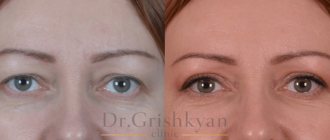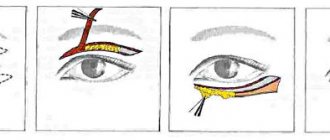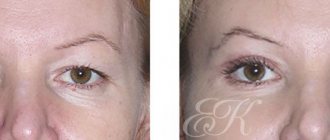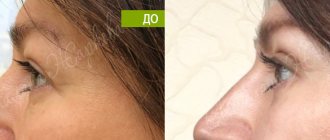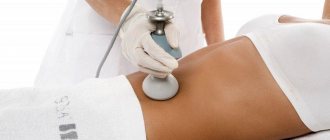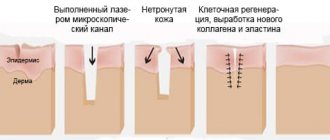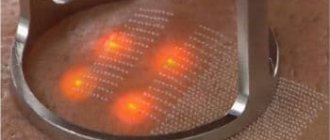Upper and/or lower eyelid surgery is also recommended if there is a desire to change the shape of the eyelids, for example, with Asian eyes or when the eyes look too round. In addition to external changes, the operation improves peripheral vision, increases a person’s self-esteem, and has a beneficial effect on the psychological state.
Indications:
- loss of elasticity, stretching of the skin of the eyelids and its excess, as a result - the appearance of a skin fold, its overhang, the formation of wrinkles, bags under the eyes;
- presence of fatty deposits around the eyes;
- tired and heavy expression in the eyes and face;
- asymmetry of the eyes.
Contraindications:
- severe concomitant diseases (heart, lung, diabetes, oncology, some blood diseases, etc.);
- the presence of infections and inflammatory processes in the body in the acute stage;
- diseases of the conjunctiva, tear ducts, the presence of dry eye syndrome, blepharospasm, etc.
Blepharoplasty is a low-traumatic operation that is one of the most popular surgical interventions. It accounts for more than 22% of all plastic surgeries. Thanks to a successful operation, it is possible to reduce the number of folds and unevenness in the skin around the eyes, eliminate sagging, which gives the look freshness and openness. But, like any operation, an eyelid lift may be accompanied by a risk of complications, so it is better to seek help in a clinic equipped with modern equipment, where experienced specialists work.
In our Center, when performing blepharoplasty, we use low-traumatic techniques that allow us to achieve excellent results. After restoration, no visible marks remain on the skin. Moreover, our eyelid surgery can be performed in combination with other plastic surgeries. To achieve an ideal appearance - face or figure - we can offer any combination of techniques!
Types of operations
- Upper blepharoplasty is the removal of excess skin and fatty tissue on the upper eyelids, leading to their drooping. This technique is an ideal solution for getting rid of the effect of heavy or drooping eyelids. In people with pronounced age-related changes, it is also possible to tighten the orbicularis oculi muscle.
- Lower blepharoplasty - this technique is recommended for eliminating folds and obtaining smoother skin of the lower eyelid. The lift is performed through an incision along the edge of the eyelashes. The operation can be performed to remove intraorbital fat tissue or be fat-sparing. Removal of fatty hernias followed by redistribution of tissue under the eyes helps eliminate bags and hollows. At the end of the operation, excess skin is excised, after which a cosmetic suture is applied.
- Circular blepharoplasty is a one-stage operation to correct the upper and lower eyelids. The technique is recommended for obtaining maximum rejuvenation effect, as well as for pronounced folds under the eyes caused by sagging tissue, or deep creases in the lower eyelids. Using this technique, you can eliminate the so-called “tired eye” syndrome. The operation can also be supplemented by lifting the corners of the eyes and changing their shape.
Lower eyelid blepharoplasty and its complications
The most common and rather unpleasant complication of lower eyelid surgery is eyelid inversion. As a rule, it occurs in patients over 60 years of age. It goes away on its own within a few days. If it does not go away, a minor outpatient intervention under local anesthesia is required. The need for this additional operation occurs very rarely. We haven't needed it even once in more than 20 years.
| EVENT | HOW LONG AFTER THE OPERATION CAN THIS BE DONE? |
| To wash hair | 1 day |
| To drive a car | 5 days |
| Going to work | 12-14 days |
| Removing stitches | 3-4 days if stitches were placed |
| Sex life | 1 Week |
| Sunbathe in the sun or in a solarium | 1-2 weeks until bruises disappear |
| Fitness with a gentle load | 2 weeks |
| Pool | 2 weeks |
| Mandatory follow-up visit to the doctor | 2 months |
A visit to a cosmetologist after lower blepharoplasty is welcome, but there are certain restrictions here too. Before starting the procedure, inform your cosmetologist that you have undergone lower eyelid surgery.
| EVENT | HOW LONG AFTER THE OPERATION CAN THIS BE DONE? |
| Lymphatic drainage facial massage | 1 Week |
| Microcurrents | 1 Week |
| Gentle cosmetic care, without mechanical cleaning | 10 days |
| Botox or Dysport injections | 3 weeks |
| Peeling | 1 month |
| Face massage | 1 month |
| Laser resurfacing | 1 month |
| Injections of hyaluronic acid preparations | 6 months |
How is the operation performed?
Correction can be performed through transconjunctival or percutaneous access. For example, upper blepharoplasty is performed through an incision in the crease of the eyelid, after which excess skin and fatty tissue are removed. With the transconjunctival approach, when correcting the lower eyelid, the incisions are made along the inner (mucous) surface of the eyelid. Due to the absence of visible marks from the scalpel, this technique is called “blepharoplasty without incisions.”
When choosing a surgical method, a number of nuances are taken into account, primarily the individual characteristics of the patient. For example, the transconjunctival technique can eliminate fatty tissue, the effect of a heavy eyelid and bags under the eyes, but is not suitable for removing excess skin. Therefore, this method is more suitable for eyelid correction in young patients and middle-aged people.
Transconjunctival blepharoplasty
This is a type of lower blepharoplasty that differs in the location of the incision. The surgeon works on the inside of the eyelid.
The doctor makes an incision on the conjunctiva. Then it removes or redistributes excess fat tissue. Sometimes, on the contrary, implants are introduced.
The surgeon then stitches the area with self-absorbing sutures.
A significant advantage of the procedure is the absence of traces of intervention.
The operation lasts from 40 minutes to one and a half hours.
The operation consists of several stages:
- preparation and marking of proposed cuts;
- anesthesia - both local and general anesthesia are possible;
- access - performed according to markings applied to the skin;
- surgical procedures, the scope of which depends on the type of surgical intervention;
- suturing - carried out using cosmetic stitches using modern suture material.
At the end of the surgical intervention, an aseptic bandage is applied to the eyelids for 4-6 hours. The duration of blepharoplasty varies from 30 to 120 minutes. Discharge is possible 2-3 days after the operation.
General recommendations
General recommendations for the recovery period after blepharoplasty surgery are the same as after any surgical procedure. Only in this case does aesthetic beauty depend on the quality of the scarring process. Basic Requirement
– do not perform actions that provoke swelling after blepharoplasty. This means that for several days before and after the operation you will have to give up salty, spicy foods, and not drink a lot of liquid at night. It is also important to refrain from exercise and lead a calm lifestyle for a month after surgery. During physical activity, the intensity of blood flow increases, and blood flows to small vessels, including those on the face. It is especially important not to sit upside down, bend over, or do any work that involves lowering your head below waist level.
Restrictions on salty foods and alcohol are in effect for 2 weeks. Salt has the property of retaining moisture in the body, and alcohol dilates blood vessels, increasing blood flow to the capillaries. Both of these provoke swelling. For the same reason, during the rehabilitation period after blepharoplasty, you should refrain from visiting the bathhouse, sauna, or beach holiday.
Expert commentary
Wrinkles and bags under the eyes, drooping eyelids, a tired look that has lost its former openness and expressiveness - such manifestations can be easily eliminated with the help of blepharoplasty. Today, the operation can be performed without external incisions; located along natural folds, they become invisible after healing. Just a few days of recovery, and the person returns to his usual lifestyle. Want to learn more about the possibilities of rejuvenation? By scheduling a consultation, you can get answers to more specific questions regarding the possibilities of correcting your eyelids. Together we will select the most suitable technique and discuss the predicted result. In our Center there is also the possibility of performing other plastic and medical operations, any combinations, in order to achieve the best result when correcting appearance and treatment!
Plastic surgeon Dmitry Alexandrovich Zimin
Advantages of treatment at the Swiss University Hospital
- The clinic’s equipment with the latest expert-class equipment allows our specialists to carry out operations of any type of complexity.
- Patients can expect comprehensive care from the initial consultation to post-recovery follow-up visits. Laboratory diagnostics for more than 5,000 indicators, any types of instrumental and hardware diagnostics, and appointments with leading specialists in more than 15 areas are available to patients.
- The clinic also performs simultaneous operations: getting rid of 5-6 diseases that require surgical treatment during one anesthesia. Plastic surgeries, removal of hernias, tumors, gastrointestinal pathologies, etc., but one preoperative examination, 1-3 days of hospitalization and a couple of weeks for recovery!
- We have our own resuscitation department and intensive care wards; after the operation, the patient is under round-the-clock monitoring by experienced staff.
- The patient rooms have everything necessary for a comfortable stay; if necessary, an individual post of experienced medical staff is possible.
Tests for additional examination
If something worries the doctor, he prescribes:
- Blood chemistry. Shows the level of bilirubin, enzymes and other substances that allow us to judge problems in the liver and kidneys.
- Survey radiograph. Its purpose is to further examine the chest organs. It is prescribed when changes are recorded in a fluorography image.
- Echocardiography. Allows you to study the myocardium and valves.
By the way, unsatisfactory research results are not always a reason to refuse the operation itself. The final decision in each case is usually made at a consultation, where specialists study the patient’s condition and weigh the risks.
Note! External factors can influence the results, changing them for both the better and the worse. Therefore, it is important to prepare not only for surgery, but also for the examination itself.
Frequently asked questions
How is rehabilitation after blepharoplasty?
Tissue swelling can persist for up to two weeks, hematomas disappear within 5-8 days. To reduce swelling, it is better to sleep with the head of the bed elevated; it is also important to avoid sudden head movements. Traces from the operation completely disappear after 3-4 weeks. In the first days, the eyes can be treated with tampons moistened with neutral agents; after 10 days, you can return to the usual hypoallergenic preparations for caring for the skin around the eyes. It is better to stop driving a car and using a computer for a couple of days after the operation. When outdoors, you should use glasses with UV protection. Intense physical activity can be resumed no earlier than three weeks after surgery.
How do you feel after surgery?
In the first days, there may be a slight feeling of tightness in the eyelid area, a short-term decrease in the sensitivity of the skin along the eyelash line. Faster eye fatigue is possible. Such manifestations go away on their own.
How long do the results of blepharoplasty last?
After the intervention, the aging process slows down, even if small excess fatty tissues form in the eye area, they will not be as pronounced as before the operation. Eyelid skin care and health status are also important; if you follow the recommendations of a specialist, you can count on long-term results.
At what age is it recommended to have blepharoplasty?
If it is necessary to correct the congenital shape of the eyes (raise the lateral corner, Europeanize the Asian eyelid), or eliminate asymmetry, the operation can be performed after the 18th birthday. It is advisable to correct age-related changes after 30 years.
Is it possible to have blepharoplasty if you have eyelid tattooing?
It is possible, but after the operation the applied image is deformed and will require correction.
Lower eyelid blepharoplasty: postoperative period
There is practically no pain in the surgical area after lower blepharoplasty. Lower blepharoplasty involves swelling and bruising. But they go away within two weeks! Stitches, if any, are usually removed on the third day.
The tissue healing process after lower eyelid surgery will be faster and more effective if you follow the regimen prescribed by your doctor. It is recommended to adhere to the following rules.
•♦ The main principle of the immediate postoperative period is 2 weeks - rest, physical and emotional. •♦ No alcohol for 2 weeks. •♦ Stay out of the sun while there are bruises - 1-2 weeks. •♦ For some time, 3-4 days, you should refrain from reading books, watching TV shows and working on the computer. •♦ Two weeks without exercise. ♦ Regular swimming pool glasses will not be suitable for 3 months after surgery.
